26th August, 2025
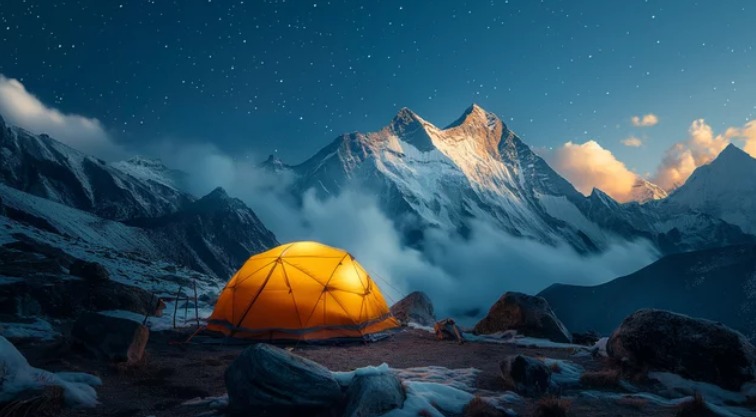
Apr 25, 2024
Island Peak Climbing In March
- I am a Beginner Climber, Can I Do This Climb?
- How Hard is Climb Island Peak?
- Distance of Island Peak
- Why Island Peak in March
- What Time of Year is Best to Climb Island Peak?
- What is the Weather Like on Island Peak in March?
- How Long Does It Take to Climb Island Peak?
- What are the Challenges of Climbing Island Peak in March?
- Suggestions for Your Island Peak Climbing in March Trip
- Highlights of Island Peak Climbing in March
- How To Reach Island Peak?
- Island Peak Climbing Duration
- Permit for Island Peak Climbing
- Final Say
- Island Peak Climbing Packages
In March, embarking on a climb of Island Peak in the Nepalese Himalayas promises a captivating adventure amidst the shifting seasons. As winter gives way to spring, the landscape undergoes a gradual transformation, with remnants of snow highlighting the rugged terrain.
The journey typically begins with a scenic flight from Kathmandu to Lukla, where trekkers immerse themselves in the vibrant Sherpa culture of the Khumbu region. Passing through picturesque villages like Namche Bazaar and Dingboche, climbers gradually ascend, acclimatizing to the increasing altitude and taking in panoramic views of snow-capped peaks.
March offers climbers stable weather conditions, characterized by clear skies that unveil the grandeur of the Himalayan panorama. Daytime temperatures at lower elevations hover between 5°C to 15°C (41°F to 59°F), providing a comfortable trekking environment. As climbers advance towards Island Peak Base Camp, situated amidst towering peaks and serene glaciers, temperatures drop, necessitating the use of warm layers and sturdy trekking gear.
The ascent to Island Peak involves navigating technical terrain, including steep slopes and a final challenging ridge climb. With minimal precipitation during this period, the route remains relatively dry, enhancing the feasibility of tackling these obstacles safely.

ISLAND PEAK CLIMBING
Sherpa Expedition & Trekking (Est.1977) are pleased to announce FOR ADVENTURERS the most awesome, exhilarating & unforgettable climbing and treks on offer anywhere today!...
At higher elevations, the air becomes noticeably thinner, requiring climbers to maintain a steady pace and prioritize proper acclimatization. The journey culminates in a demanding yet exhilarating summit push, where climbers are rewarded with breathtaking views from the peak's 6,189-meter (20,305-foot) summit.
Descending amid the lingering winter beauty of the Himalayas, climbers return with a profound sense of achievement and memories of an awe-inspiring journey through one of the world's most iconic mountain landscapes.
I am a Beginner Climber, Can I Do This Climb?
For beginner climbers, attempting Island Peak in the Himalayas is a challenging yet feasible goal with proper preparation and guidance. While prior trekking experience at high altitudes is beneficial, many beginners successfully summit Island Peak each year. Opting for guided expeditions provides essential support, including equipment, experienced guides, and training in basic mountaineering skills like using crampons and ropes. Commitment to physical training, altitude acclimatization, and mental preparedness are key factors in ensuring a safe and enjoyable climb for beginners.
How Hard is Climb Island Peak?
Island Peak presents a moderate challenge in mountaineering terms. While it is not as technically demanding as some higher Himalayan peaks, it involves steep ascents, glacier crossings, and a final challenging ridge climb to the summit at 6,189 meters (20,305 feet). The difficulty of the climb varies with weather conditions and individual fitness levels. Adequate preparation, including physical conditioning and familiarity with mountaineering equipment, is essential for a successful ascent.
Distance of Island Peak
Island Peak is located in the Khumbu region of Nepal, near Everest Base Camp. The trek typically begins with a flight from Kathmandu to Lukla, followed by a trek through scenic Sherpa villages and rugged terrain. The direct distance from Lukla to Island Peak Base Camp is approximately 50 kilometers (31 miles), though the total trekking distance is longer due to the mountainous terrain and altitude gain. It usually takes around 10 to 12 days to reach Island Peak Base Camp, allowing for acclimatization and gradual ascent.

ISLAND PEAK SUMMIT RETURN BY HELICOPTER
Many of us only dream of standing on a tall peak looking down on the world. This is a great climb that will satisfy this desire. Island Peak, also referred to as Imja Tse, is a 6187-meter high peak in...
Why Island Peak in March
March is an optimal month for climbing Island Peak due to favorable weather conditions and manageable temperatures. As winter transitions to spring, climbers benefit from stable weather with clear skies and minimal precipitation. This period offers ideal climbing conditions, making it safer and more comfortable to navigate the technical terrain and achieve a successful summit. Additionally, March sees fewer climbers compared to peak seasons, providing a quieter and more serene experience amidst the breathtaking Himalayan landscape.
What Time of Year is Best to Climb Island Peak?
The best time to climb Island Peak, located in the Himalayas of Nepal, is typically during the pre-monsoon (spring) and post-monsoon (autumn) seasons. These periods provide the most stable weather conditions and optimal climbing conditions.
- Spring Season (March to May): Spring is considered one of the best times to climb Island Peak. During this season, the weather is relatively stable with clear skies and mild temperatures. The days are longer, providing ample daylight for climbing, and the route is usually dry, making it safer and more manageable.
- Autumn Season (September to November): Autumn is another favorable season for climbing Island Peak. The weather is cool and stable, similar to spring, with clear skies and minimal precipitation. The temperatures are comfortable during the day, although nights can be cold at higher elevations.
Both spring and autumn seasons offer stunning views of the Himalayan landscapes, including Everest and neighboring peaks, enhancing the overall climbing experience. Climbing during these seasons also coincides with popular trekking periods in the region, providing opportunities to explore other iconic destinations like Everest Base Camp.
What is the Weather Like on Island Peak in March?
In March, Island Peak experiences transitioning weather conditions as winter gives way to spring in the Himalayas. Daytime temperatures at lower elevations, such as Lukla, range from 5°C to 15°C (41°F to 59°F), offering comfortable trekking conditions. However, at higher elevations like Island Peak Base Camp (approximately 5,200 meters or 17,060 feet), temperatures can drop significantly, with daytime temperatures ranging from -10°C to -5°C (14°F to 23°F). Nights are colder, often reaching below freezing.
March is characterized by clear skies and minimal precipitation, making it an ideal month for climbing Island Peak. The stable weather conditions provide good visibility and reduced risks associated with inclement weather. Climbers can expect dry terrain and manageable snow conditions on the route, although careful preparation and proper gear for cold temperatures are essential.
How Long Does It Take to Climb Island Peak?
The duration to climb Island Peak varies depending on the chosen itinerary and individual acclimatization needs. Typically, the climb is part of a larger trekking expedition in the Khumbu region of Nepal, which includes reaching Island Peak Base Camp and then ascending to the summit. Here's a general timeframe:
- Trekking to Island Peak Base Camp: The trek from Lukla (after a flight from Kathmandu) to Island Peak Base Camp takes approximately 7 to 10 days. This period allows for gradual acclimatization, passing through villages like Namche Bazaar and Dingboche along the way.
- Summit Day: From Island Peak Base Camp, climbers typically make an early morning ascent to the summit. The climb to the summit and descent back to Base Camp can take around 10 to 12 hours, depending on weather conditions, snow conditions, and individual pace.
- Total Duration: Including acclimatization days and contingency for weather delays, a typical Island Peak climbing expedition lasts about 18 to 20 days. This timeframe ensures climbers have sufficient time to adapt to the altitude, reducing the risk of altitude-related illnesses, and to safely complete the ascent and descent.
Proper planning, including physical training, altitude acclimatization, and adequate rest, is crucial for a successful and safe climb of Island Peak within the recommended timeframe.
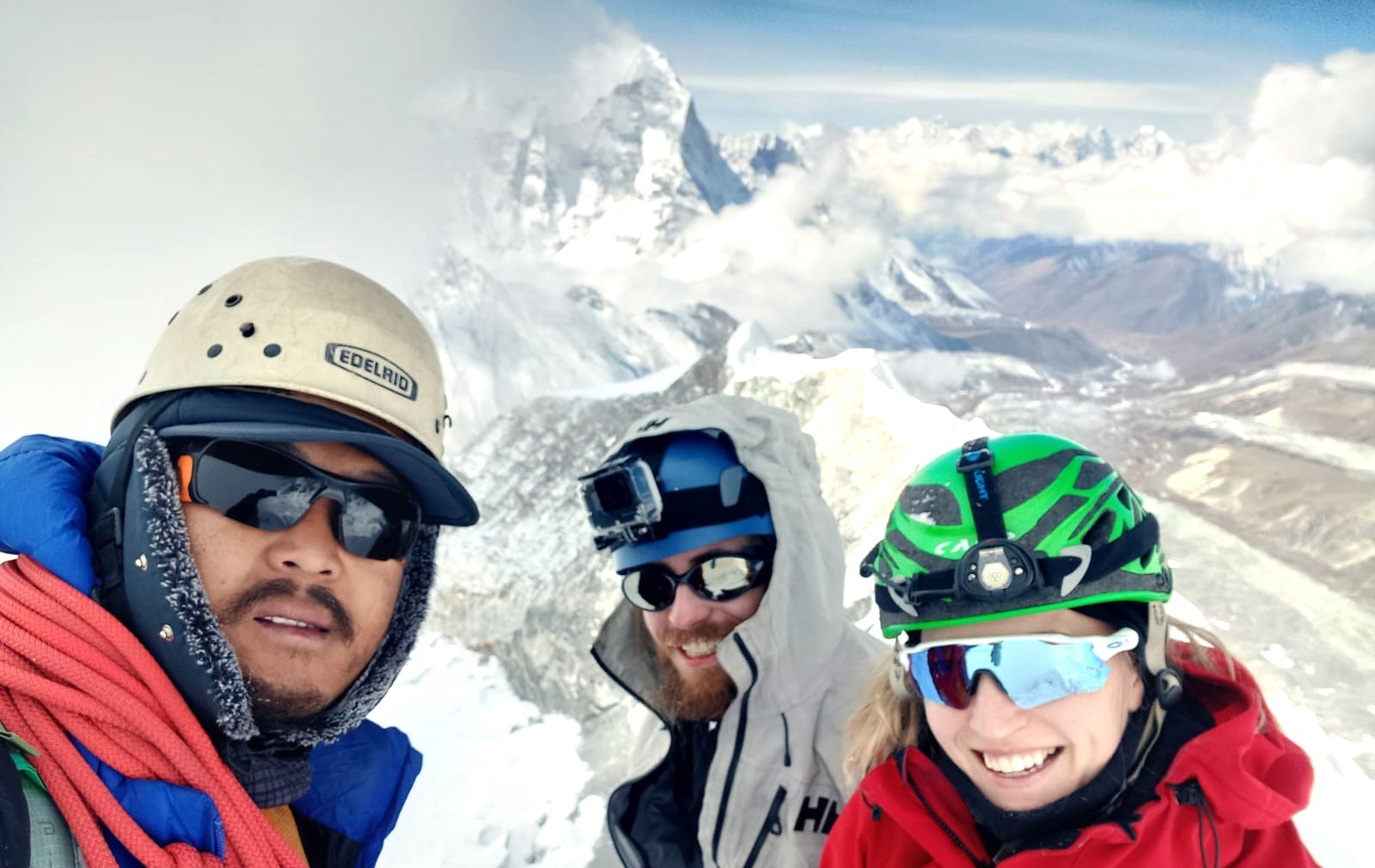
ISLAND PEAK EXPEDITION 15 DAYS
Island Peak, also known as Imja Tse, is a popular peak located in the Khumbu region of Nepal. This peak is a part of the Himalayas and stands tall at a height of 6,189 meters above sea level. Island P...
What are the Challenges of Climbing Island Peak in March?
Climbing Island Peak in march presents unique challenges despite being an ideal month for mountaineering in the Himalayas. April marks the start of the pre-monsoon season, characterized by changing weather patterns that can bring sudden storms and increased precipitation.
- Weather Variability: March can experience rapid weather changes, including snowfall and high winds. Climbers must be prepared for these conditions and adapt their ascent accordingly.
- Crowds: March is a popular time for trekking and climbing in Nepal, including routes to Everest Base Camp and Island Peak. This can lead to crowded trails and base camps, potentially affecting the overall experience.
- Altitude and Acclimatization: Island Peak stands at 6,189 meters (20,305 feet), posing altitude-related challenges. Adequate acclimatization is crucial to prevent altitude sickness and ensure a safe ascent.
- Technical Terrain: The final ascent to Island Peak involves technical sections such as steep slopes, glacier crossings, and a challenging ridge climb. Snow and ice conditions in March can increase the difficulty of these sections.
Suggestions for Your Island Peak Climbing in March Trip
- Early Planning: Book permits and accommodations well in advance due to high demand during March.
- Weather Monitoring: Stay informed about weather forecasts and be prepared for sudden changes in weather conditions.
- Physical Preparation: Focus on cardiovascular fitness, strength training, and altitude acclimatization prior to the trip.
- Gear Preparation: Ensure you have appropriate clothing and equipment for cold temperatures, snow, and technical climbing.
- Guided Expedition: Consider joining a guided expedition with experienced guides who can provide support, safety, and expertise in navigating the terrain and conditions.
Highlights of Island Peak Climbing in March
March offers climbers several highlights that enhance the experience of summiting Island Peak:
- Scenic Beauty: March showcases the Himalayan landscape at its finest, with clear skies providing stunning views of snow-capped peaks and glaciers.
- Cultural Experience: Trekking through Sherpa villages like Namche Bazaar and Dingboche allows for cultural immersion, with opportunities to visit monasteries and interact with local communities.
- Achievement: Summiting Island Peak in March provides a sense of accomplishment, standing atop one of Nepal's iconic peaks and enjoying panoramic views of the Everest region.
- Photography Opportunities: The clear skies and vibrant landscapes in March offer excellent photography opportunities, capturing the beauty of the Himalayas and your climbing journey.
- Adventure and Challenge: march combines adventure with the challenge of technical climbing, making it a memorable experience for mountaineers seeking both excitement and achievement in the mountains.
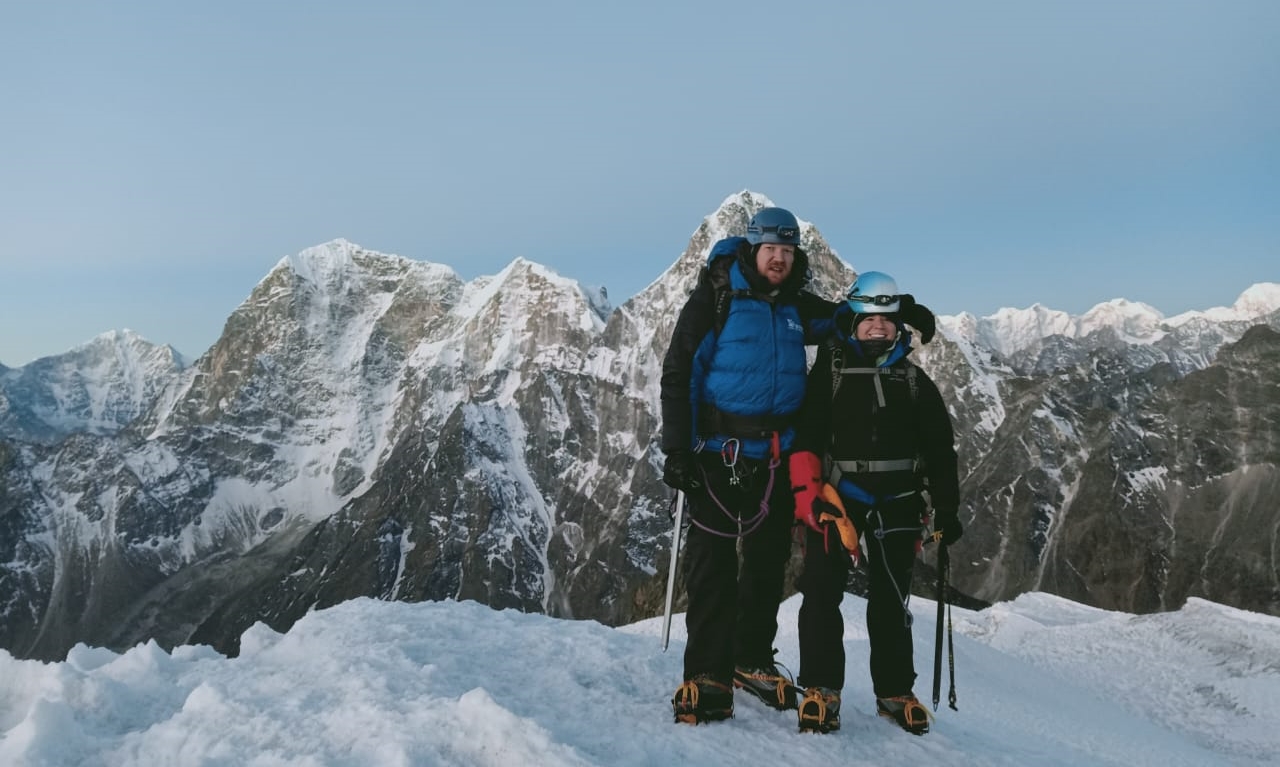
LOBUCHE PEAK CLIMBING
Lobuche East (6,119m/20,075ft), set in Nepal's stunning Khumbu on the Nepalese side of Everest.The best time to go trekking in Nepal is in Autumn (September-November) and in...
How To Reach Island Peak?
Reaching Island Peak, situated in the Khumbu region of Nepal, typically involves a multi-day trek starting from Kathmandu.
- Flight to Lukla: Begin with a scenic 30 to 40-minute flight from Kathmandu to Lukla, a gateway town in the Everest region.
- Trek to Namche Bazaar: From Lukla, trek through picturesque Sherpa villages like Phakding and Monjo before reaching Namche Bazaar. This trek takes about 2 to 3 days.
- Acclimatization: Spend a day in Namche Bazaar for acclimatization, exploring the local culture and adjusting to the altitude.
- Trek to Dingboche: Continue trekking past Tengboche Monastery to Dingboche, another acclimatization stop. This leg of the journey takes around 2 to 3 days.
- Base Camp: Trek from Dingboche to Island Peak Base Camp, passing through Chukhung Valley. The trek to Base Camp typically takes 1 to 2 days.
- Summit Ascent: From Base Camp, climbers undertake a summit push, usually involving a pre-dawn start to reach the summit and return to Base Camp the same day.
Island Peak Climbing Duration
The total duration for climbing Island Peak ranges from 18 to 20 days, including trekking to Base Camp, acclimatization days, and the summit attempt.
- Trekking: The trek from Lukla to Base Camp takes approximately 10 to 12 days, allowing for gradual altitude acclimatization.
- Acclimatization: Spend several days acclimatizing at Namche Bazaar, Dingboche, and Island Peak Base Camp to prepare for the summit push.
- Summit Attempt: The summit attempt from Base Camp usually takes 1 to 2 days, with climbers ascending early in the morning and returning to Base Camp the same day.
- Return Trek: After summiting Island Peak, trekkers retrace their steps back to Lukla, typically taking 5 to 6 days.
Permit for Island Peak Climbing
Climbing Island Peak requires several permits, which can be obtained through registered trekking agencies in Nepal:
- Sagarmatha National Park Entry Permit: Required for entering the Sagarmatha National Park, where Island Peak is located.
- Khumbu Rural Municipality Entry Permit: Required for trekking in the Khumbu region.
- Island Peak Climbing Permit: Issued by the Nepal Mountaineering Association (NMA) and required specifically for climbing Island Peak.
- TIMS Card (Trekker's Information Management System): Generally required for all trekkers in Nepal to ensure safety and security.
Ensure all permits are obtained in advance through your trekking agency, as regulations and fees may vary.
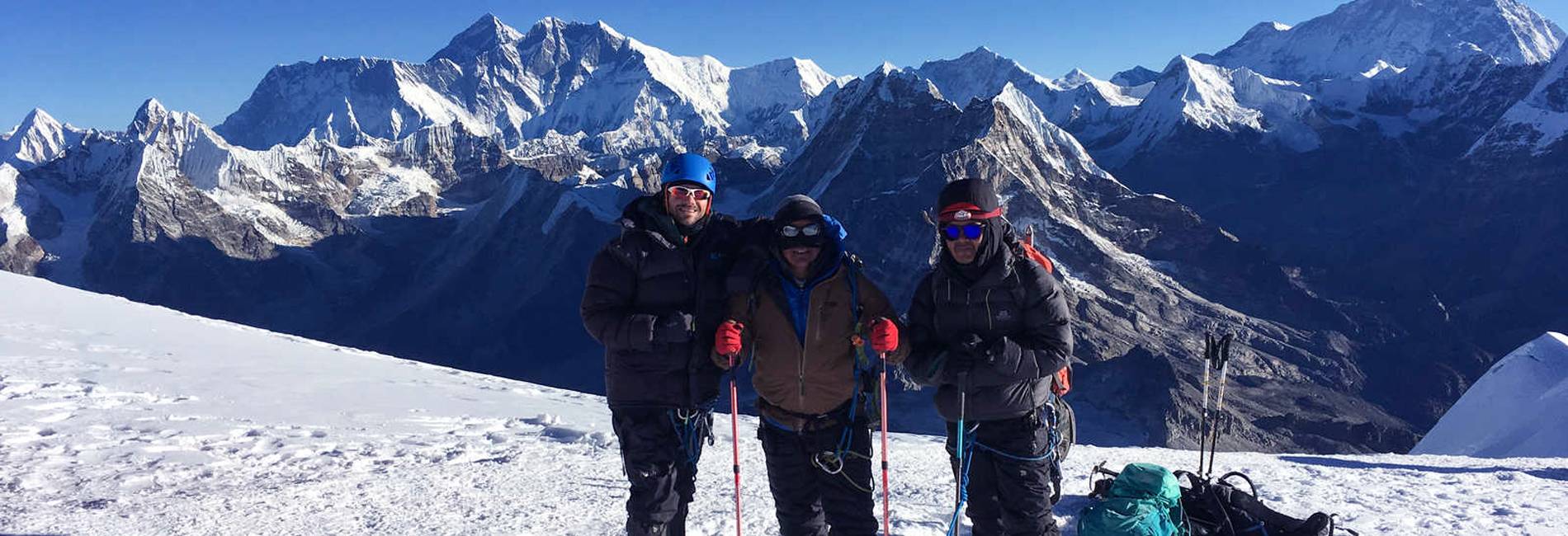
MERA PEAK CLIMBING
Mera Peak Climbing is an exhilarating adventure in Nepal that gives you an opportunity to reach the summit of Mera Peak at more than 6400m above sea level. Actually, it is the highest climbing (w...
Final Say
Climbing Island Peak is a challenging yet rewarding endeavor that combines trekking through stunning Himalayan landscapes with technical mountaineering. Preparation, including physical training, acclimatization, and proper gear, is crucial for a safe and successful ascent. With the support of experienced guides and careful planning, climbers can experience the thrill of summiting a 6,000-meter peak and enjoy breathtaking views of the Everest region.
Island Peak Climbing Packages
Island Peak Summit Return By Helicopter
Island Peak Expedition 14 Days
Island Peak Expedition 15 Days
Everest Three Pass with Island Peak Climbing
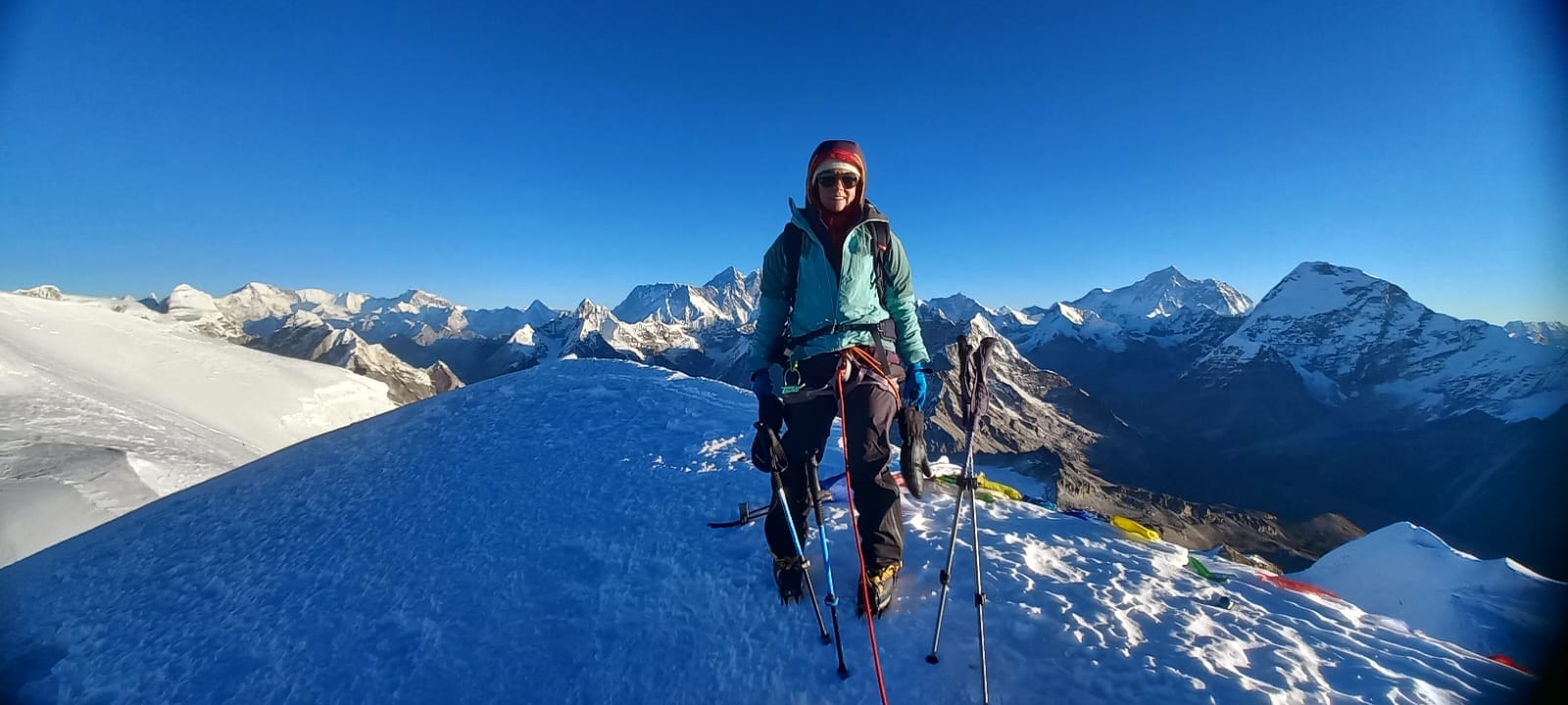
Three Peak Expedition
Embark on an unforgettable journey to the heart of the Himalayas as you conquer three majestic peaks: Mera Peak, Island Peak, and Lobuche Peak. This ultimate adventure combines technical climbing, bre...
Any Questions? Let Us Know.
Recent Posts
17th June, 2025


















